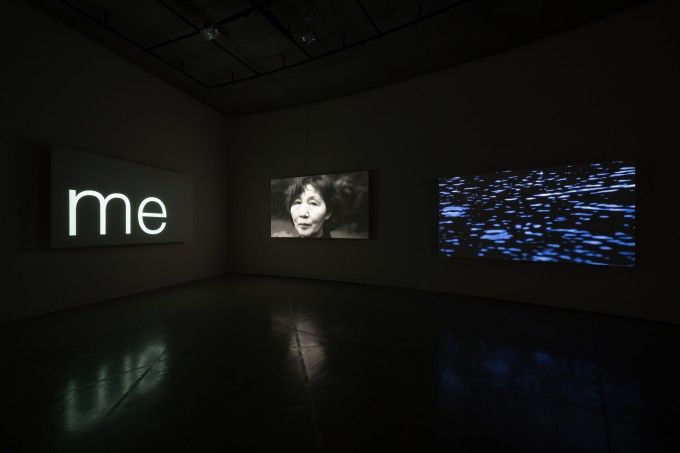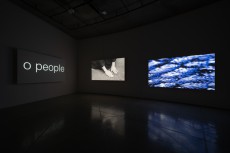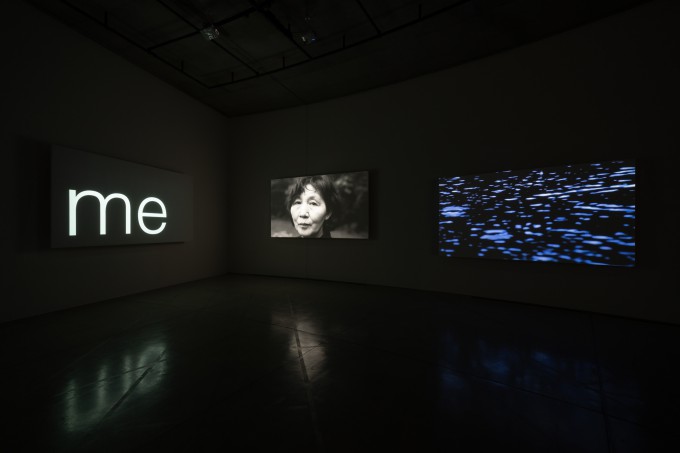
Dynamic Garden in Full Motion
Saturday, July 28th unyil Sunday, September 9th, 2018
Gabriella MANGANO & Silvana MANGANO

Photo: KATO Ken
The Ephemeral Present and All Bodies
KANEKO Yukiko
A woman appears on a screen, and she moves her hand as if she were tracing her own body and the ground. It goes from her fingertips to the shoulder, the side of the ear, over the head and the other ear. It traces her side, feet and reaches the ground. Once it reaches the ground, she slowly moves it on the ground surface as if she confirmed. Shown on the screen to the right are how tree branches sway in the wind, how pine needles and nut chips flow on the water surface, and how raindrops make ripples and how the wind stirs the water, in bluish tone. The pine leaves on the water surface flow fast at times, slowly at other times and go straight and then whirl changing their forms irregularly. The ripples make regular patterns, and raindrops echoing each other make ripples that disappear in a moment. The movements of these trees and water seem to resonate with the women’s movements of tracing the ground. And on the leftmost screen, words such as “mountain,” “day,” “arrived,” “moving,” and “dormant” appear and disappear. The earth-tremoring sound strong and weak is heard as if it filled in the whole exhibit space. It could be a sound reverberating from inside the women, or it could be the earth’s sound responding to the women. Surrounded by such sound, the viewer regards the three screens.
Sisters Gabriella Mangano and Silvana Mangano produced a work during their residency based on a passage from a poem by YOSANO Akiko, which begins with “The day when the mountains move has come” in “Sozorogoto (Rambling remarks)” published in the first issue of Seito (meaning “bluestocking” in Japanese), magazine for women by female writers and editors in Japan in 1911. At that time, Japanese women did not have suffrage and the role model of a Japanese woman was a good wife and wise mother who would fit in the male-centered family system. In the first phrase of the poem that reads, “All the sleeping women are now awake and moving,” the woman is compared to a dormant volcano, and it inspired women of those days.
Even at present, one hundred years later, this poem continues to inspire women. Around 2017, one year before this program was held, it was a time when #Me Too, the sexual harassment accusation movement through SNS and the women’s movement against the inauguration of the U.S. President who had made sexist remarks spread around the world, and the campaign on the status improvement of women was rising. This work by Mangano sisters produced during this residency program can also be seen as a response to this social phenomenon. While this work responds to the social situation in 2018 and deals with the present, it is involved in two kinds of time—the momentary time as the present and time taken in a longer perspective of one hundred years.
Their study of time is also seen in their sculpture, “Her Past, Her Future.” Here, two white pieces of square timber are shaped like a mountain. On the top part of the center where the two pieces of timber meet, the sunset and the sunrise, which never meet, are facing each other in a space between the pieces of timber. What the sunset symbolizes is the accumulation of the past day as well as the beginning of the night. And what the sunrise symbolizes is the accumulation of the time up until the night, yesterday and the beginning of the day that starts now. Both the sunrise and the sunset are involved in the past and the future, and the present appears in a space between the two suns. The present becomes the past as soon as we become aware of it, thus it cannot be grasped in reality. The present is part of the ceaseless flow of time going from the past to the future, and it is the only special moment that never repeats. The present floats ephemerally in the space and is shaped by the past and the future.
The woman who appears in When mountains move at the beginning is not alone. The moment I think there is a woman, she has been replaced by another woman before the viewer is aware. Every woman who appears one after another wears loose and uniform clothing, and they are tracing their bodies and the ground surface as if they were confirming that their bodies and the ground are certainly there under their feet and trying to make their contours appear. How the women repeat similar actions seems to reflect how they make a group and their accumulated intentions are moving each woman. Although they are wearing similar clothes and moving in the similar way, each woman has her own body and face. Here, while each of them exists as an individual, they unify women in the days of “Seito,” those who lived before that and those who would emerge in the future. The only one body here and now involves all the bodies of women who have lived so far and will live from now on.
One body involves all bodies and that continues from the past to the future. The body exists in the transient present, and it certainly exists there containing everything. That the women continue to move quietly as if moving their bodies here and now means to move all bodies and make them resonate, spreading out ripples from the past to the future.

When mountains move

未完の庭、満ちる動き
2018年7月28日(土)-9月9日(日)10:00 18:00、会期中無休、無料
ガブリエラ・マンガノ&シルヴァーナ・マンガノ
Gabriella MANGANO & Silvana MANGANO

撮影:加藤健
儚い現在、全ての身体
金子 由紀子
1つのスクリーンに女性が現れ、自身の身体や地面をなぞるように手を動かしている。指先から肩を通り、耳の横から頭の上を通って反対側の耳へ。そして脇腹をなぞりながら足に下りていき、そこから地面に到達する。地面に到達すると、確認するようにゆっくりと地表の上の手を行き来させる。その右隣のスクリーンでは木の枝が風に揺れる様子や、水面を松の葉や木の実の屑が流れる様子、雨粒が波紋を作る様子や風がさざ波を立てる様子が青味がかった色調で捉えられている。水面を流れる松の葉は、時に速く、時にゆっくりと、直線的だったり渦巻いていたり、不規則に変化しながら流れていく。さざ波は規則正しい模様を作り、雨粒は隣同士で響きあいながら一瞬で消える波紋を作る。それらの木や水の動きは、女性達が大地をなぞる動きに共鳴するようでもある。そして左のスクリーンにはmountain(山)、day(日)、arrived(来る)、moving(動く)、dormant(休止の・潜在の)、などの単語が現れては消える。そして展示空間を埋めるように、ゴーっという地響きのような音が強弱を付けながら絶え間なく聞こえている。女性達の内から響く音のようでもあり、女性達に呼応する大地の音のようでもある。鑑賞者はその音に包まれながら3つのスクリーンを目の中に捉える。
ガブリエラ・マンガノ&シルヴァーナ・マンガノは本滞在制作で、1911年に日本で女性の執筆者と編集者によって発行された女性のための雑誌『青鞜』の創刊号に掲載された与謝野晶子の詩「そぞろごと」の中の「山の動く日来る」から始まる一節をモチーフとして作品を制作した。創刊当時、日本の女性に選挙権は無く、男性中心の家制度の中に納まる良妻賢母がよい女性のモデルとされていたが、この詩1節目では女性を活動休止中の火山に例えて描き、「すべて眠りし女 今ぞ目覚めて動くなる」と当時の女性達を鼓舞した。
この詩は同時に100年後の現在もなお、女性達を鼓舞する。本プログラムの開催1年ほど前の2017年頃は、SNSを通じたセクシャルハラスメントの告発運動「#Me Too」や、女性蔑視発言の過去を持つアメリカ大統領の就任に反対する女性達による運動が世界中に波及し、女性の地位向上に関する運動が盛り上がりを見せていた時期であった。マンガノが本滞在で制作した作品は、この社会状況への応答でもある。よって本滞在制作作品は、2018年の社会状況に応答し現在を扱うものでありながら、同時に100年前の詩へ応答することで、現在という一瞬の時間と、100年というもっと長い視点で捉えた時間の、2つの時間を扱う。
この時間に対する考察は、彫刻作品《彼女の過去、彼女の未来》で見られる。ここでは2本の白い角材が山のような形に組まれている。2本の角材が出合う中心の頂上部分では、本来出合うことの無い夕日と朝日が角材の隙間を挟んで向き合っている。夕日が象徴するものは過ぎ去った日の蓄積でもあり、これから始まる夜でもある。そして朝日が象徴するのは、ここまでの夜と昨日までの時間の蓄積でもあり、これから始まる日でもある。朝日と夕日の双方が過去と未来を孕み、二つの太陽の隙間に、現在が現れてくる。現在は意識した瞬間に過去になり、実際には捉えることができない。現在は過去から未来へ途切れることの無い時間の流れの中の一部分であると同時に、決して繰り返すことの無い唯一の特別な瞬間でもある。現在は隙間に儚く浮遊し、過去と未来によってその形を象られる。
冒頭の映像作品《山の動く時》に現れる女性は一人ではない。一人の女性が居るかと思うと、いつの間にかそれは別の女性になっている。入れ替わり立ち替わり現れる女性達は皆、ゆったりとした揃いの衣装をまとい、身体をなぞり、地表をなぞっている。それは、自らの身体と足元の大地が確かにそこに在ることを確認し、輪郭を浮き出させようとするようだ。同じような動作を繰り返す様子は、女性達が一つの群となり、その内に堆積した意思がそれぞれの女性達を動かしているようでもある。しかし、同じような服を着て同じような動作をしながらも、女性達を統べる。今、ここにあるたった一つの身体は、ここまでとここからに連綿と続く女性達全ての身体でもある。
一つの身体は全ての身体を内包し、過去から未来へと続く。一つの身体は儚い現在に在るが、しかし全てを内包して、確実にそこに在る。今ここにある一つの身体を動かすことは、全ての身体を動かし共鳴させ、過去と未来へとさざ波を広げていくことであると、女性達は静かに動き続ける。

《山の動く時》When mountains move

《彼女の過去、彼女の未来》Her past, her future
